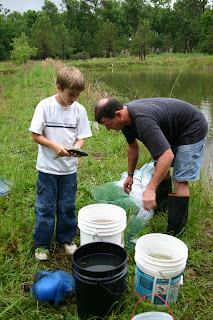This fish endeavor was all new to us, so we took the recommendation of the representative in the Florida Dept of Aquaculture and contacted a fish farmer in Micanopy, Florida which is about 4 hours from here. Supposedly this was the closest grower and he was terminating the tilapia side of his aquaculture business and had some fish to get rid of. One of the stipulations of being licensed and raising tilapia is that you must hold a business license and you must sell the fish commercially.
My husband and two sons and I made the drive to Micanopy on a bright sunny day - that is, until we arrived - then it began to rain. We were taken to his ponds where he began to throw fish food to entice the tilapia to come close enough so that Bob could throw a cast net over them. Tilapia are not a sport fish. They are a fresh water cichlid - like an oscar in a fish aquarium - they don't take a hook so they can only be caught with a net.
The owner showed us how to sex the fish by looking at their vent, but he was not very convincing as to the exactness of this method.
This is what Blue Tilapia look like - these are very small fish - about 2/3 pound. Typically we grow them to about 4 or 5 pounds.
It didn't take long before we had 50 or so fish in 5 gallon buckets which we then transported to the back of the pickup where Bob had 30 gallon drums of water waiting with an intricate aeration system hooked up.
We laugh about this now; back then we were afraid the fish would stress without oxygen for the 4 hour car ride back. Now we know that they are a tough fish and can literally gasp air from the surface if their tank lacks oxygen.
On the drive back home we had to stop at the agricultural inspection station at the Suwannee River. We had all our paperwork and certification ready, thinking that we would be inspected, but the officer just looked at the card and waved us through because there is no restriction on tilapia at the Suwannee River - not until you travel further west to the St Marks River are they controlled.
By the time we reached the farm it was dark and late. We had no outdoor lights except one security light on a power pole, and by that lamplight we began to sort the fish. We were specifically looking for several male fish to put into an aquarium in the house - male tilapia incubate fish eggs in their mouth and we wanted a few hundred new hatchlings to try an experiment we read about to sex all the babies into males by feeding them a percentage of testosterone in their first 30 days of feed. New hatchlings are neither male nor female. Many factors in the environment determine the percentage of males to females. The males grow more quickly and become a better food product in less time. The technique is to regulate the new hatchlings to all become male. So there we were, extremely tired, peering into fish mouths in the dark searching for eggs.
Several of the males with eggs went into the aquarium in the house while the rest of the fish were carried and released into the swimming pools.
Unfortunately, the best-laid plans of mice and men often go awry.
Some lived, some died, but eventually they all ended up in the outside swimming pools - males and females.
Thus began our tilapia experience.




No comments:
Post a Comment